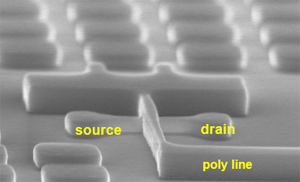The new processors from Intel have arrived.
For a fantastic overview of the road to Conroe, check out this retrospective from Tom’s Hardware. Intro:
History may credit AMD almost as much as Intel with the creation of the Woodcrest, Conroe, and Merom architectures, the latter two of which Intel released today. In 2004, AMD effectively threw down a very sizeable gauntlet, challenging Intel on every conceivable front, including retail outlets and courtrooms, to innovate or perish. In good time, Intel responded, with a marketing program and technology initiative that many felt was contrived, inconclusive, lacking vigor.
Intel’s Israel design team spelled out for the company the extent of what it had to do to meet AMD’s challenge: The NetBurst architecture was a physical and thermal dead end. Intel had to stop, repurpose itself, and build the most convincing low-power, high-performance architecture in history, from scratch. It would be an impossible task for any other company. Whether Intel has actually succeeded will depend on the next few months of extensive user testing. But we’ve seen the power of Intel’s new launch vehicle, and the capability for it to meet and probably exceed anything AMD ever anticipated, appears to be there.
Giving credit to AMD for Conroe might just cause Sharikou‘s head to explode 🙂 But the benchmarks are pretty clear: Core Duo 2 blows the Athlon FX away – with no sacrifices in price, performance, or power consumption. The time has come for mobile-on-desktop computing.

 1. Get a macbook and turn it over so the screens over the edge of your desk/counter (shown in picture)
1. Get a macbook and turn it over so the screens over the edge of your desk/counter (shown in picture) According to Intel’s long term roadmap, Penryn will become the last “Core” (NGMA) microarchitecture, but it will not become the last 45nm generation. A new architecture, based on the Nehalem core, will make an appearance in 2008. This Core successor, dubbed by many as NGMA2, will essentially take all of the 45nm manufacturing principles of Penryn and apply them to the totally new Nehalem architecture. This transition will be very similar to the P6+ transition with Yonah from Dothan to Conroe.
According to Intel’s long term roadmap, Penryn will become the last “Core” (NGMA) microarchitecture, but it will not become the last 45nm generation. A new architecture, based on the Nehalem core, will make an appearance in 2008. This Core successor, dubbed by many as NGMA2, will essentially take all of the 45nm manufacturing principles of Penryn and apply them to the totally new Nehalem architecture. This transition will be very similar to the P6+ transition with Yonah from Dothan to Conroe.